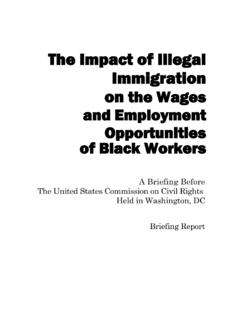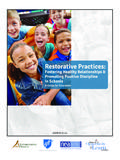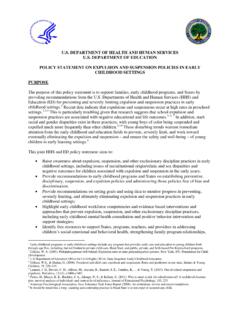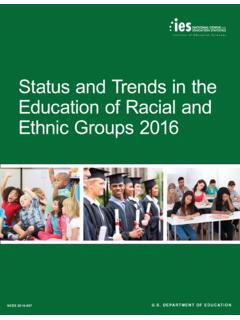Transcription of Examining School Discipline Policies and Connections to ...
1 COMMISSION ON CIVIL COMMISSION ON CIVIL RIGHTS Washington, DC 20425 Official BusinessPenalty for Private Use $300 Visit us on the Web: School Discipline Policies and Connections to the School -to-Prison Pipeline for Students of Color with DisabilitiesBRIEFING REPORT JULY COMMISSION ON CIVIL RIGHTSThe Commission on Civil Rights is an independent, bipartisan agency established by Congress in 1957. It is directed to: Investigate complaints alleging that citizens are being deprived of their right to vote by reason of their race, color, religion, sex, age, disability, or national origin, or by reason of fraudulent practices.
2 Study and collect information relating to discrimination or a denial of equal protection of the laws under the Constitution because of race, color, religion, sex, age, disability, or national origin, or in the administration of justice. Appraise federal laws and Policies with respect to discrimination or denial of equal protection of the laws because of race, color, religion, sex, age, disability, or national origin, or in the administration of justice. Serve as a national clearinghouse for information in respect to discrimination or denial of equal protection of the laws because of race, color, religion, sex, age, disability, or national origin.
3 Submit reports, findings, and recommendations to the President and Congress. Issue public service announcements to discourage discrimination or denial of equal protection of the 142 OF THE COMMISSIONC atherine E. Lhamon, ChairpersonPatricia Timmons-Goodson, Vice ChairpersonDebo P. AdegbileGail L. HeriotPeter N. KirsanowDavid KladneyKaren NarasakiMichael YakiMauro Morales, Staff Commission on Civil Rights 1331 Pennsylvania Avenue, NW Washington, DC 20425(202) 376-8128 voice TTY Relay: Suspensions: Examining School Discipline Policies and Connections to the School -to-Prison Pipeline for Students of Color with Disabilities Briefing Before The United States Commission on Civil Rights Held in Washington, DC Briefing Report July 2019 [This page intentionally left blank] Letter of Transmittal July 23, 2019 President Donald J.
4 Trump Vice President Mike Pence Senate Majority Leader Mitch McConnell Speaker of the House Nancy Pelosi On behalf of the United States Commission on Civil Rights ( the Commission ), I am pleased to transmit our briefing report, Beyond Suspensions: Examining School Discipline Policies and Connections to the School -to-Prison Pipeline for Students of Color with Disabilities. The report is also available in full on the Commission s website at For this report, the Commission investigated School Discipline practices and Policies impacting students of color with disabilities and the possible Connections to the School -to-prison pipeline, examined rates of exclusionary Discipline , researched whether and under what circumstances School Discipline Policies unfairly and/or unlawfully target students of color with disabilities, and analyzed the federal government s responses and actions on the topic.
5 The Commission s report reflects that several decades of research demonstrate persistent racial disparities in disciplinary rates and disparities based on disability status but much of scholarship based on this data has not analyzed how these Policies affect those students who live at the intersection of these two identities. The literature available, however, does suggest that students of color with disabilities face exclusionary Discipline pushing them into the School -to-prison pipeline at much higher rates than their peers without disabilities. And while exclusionary Discipline has been shown to be harmful for the educational attainment of all students, students with disabilities, particularly those who are students of color, face even more challenges when they are not able to receive a quality education.
6 The Commission majority (six Commissioners in favor, two Commissioners in opposition) approved key findings including the following: Students of color as a whole, as well as by individual racial group, do not commit more disciplinable offenses than their white peers but black students, Latino students, and Native American students in the aggregate receive substantially more School Discipline than their white peers and receive harsher and longer punishments than their white peers receive for like offenses. Students with disabilities are approximately twice as likely to be suspended throughout each School level compared to students without disabilities.
7 UNITED STATES COMMISSION ON CIVIL RIGHTS 1331 Pennsylvania Ave., NW Suite 1150 Washington, DC 20425 Data the Department of Education reports show a consistent pattern of schools suspending or expelling black students with disabilities at higher rates than their proportion of the population of students with disabilities. Data show the large majority of out-of- School suspensions are for non-violent behavior. The most recent available data reflect that, with the exception of Latinx and Asian American students with disabilities, students of color with disabilities were more likely than white students with disabilities to be expelled without educational services.
8 Research reflects that, in addition to missed class time, excessive exclusionary Discipline negatively impacts classroom engagement and cohesion and increases the likelihood excluded students will be retained in grade, drop out of School , or be placed in the juvenile justice system. Research also shows that zero tolerance Policies and the practice of exclusionary Discipline in schools in the absence of consideration and application of alternatives to exclusionary Discipline are ineffective in creating safe and healthy learning environments for students, teachers, and staff. The Commission majority voted for key recommendations, including the following: The Department of Education s Office for Civil Rights (OCR) should continue offering guidance to School communities regarding how to comply with federal nondiscrimination laws related to race and disability in the imposition of School Discipline .
9 It is critical that all teachers are provided with resources, guidance, training, and support to ensure nondiscriminatory Discipline in schools. Congress should continue to provide funding to help states and School districts provide training and support and, with Congressional appropriation support, the Departments of Justice and Education should continue and expand their grant funding for these important goals. OCR should rigorously enforce the civil rights laws over which it has jurisdiction, to address allegations of discrimination in School Discipline Policies . We at the Commission are pleased to share our views, informed by careful research and investigation as well as civil rights expertise, to help ensure that all Americans enjoy civil rights protections to which we are entitled.
10 For the Commission, Catherine E. Lhamon Chair i TABLE OF CONTENTS TABLE OF CONTENTS TABLE OF CONTENTS .. i ACKNOWLEDGEMENTS .. i EXECUTIVE SUMMARY .. 3 INTRODUCTION: RELEVANT CIVIL RIGHTS LAW .. 13 Constitutional Law: Equal Protection and Due Process Rights .. 13 Statutory Protections for Students of Color and Students with Disabilities .. 17 CHAPTER 1: School Discipline Policies AND THEIR EFFECTS .. 27 The School -to-Prison Pipeline .. 37 Policing in Schools .. 42 Exclusionary Discipline Practices .. 63 Suspensions and Expulsions .. 64 Restraint and Seclusion .. 80 Alternative Disciplinary Approaches .. 83 CHAPTER 2: CONTRIBUTING FACTORS TO THE School -TO-PRISON 93 Inside the classroom.







